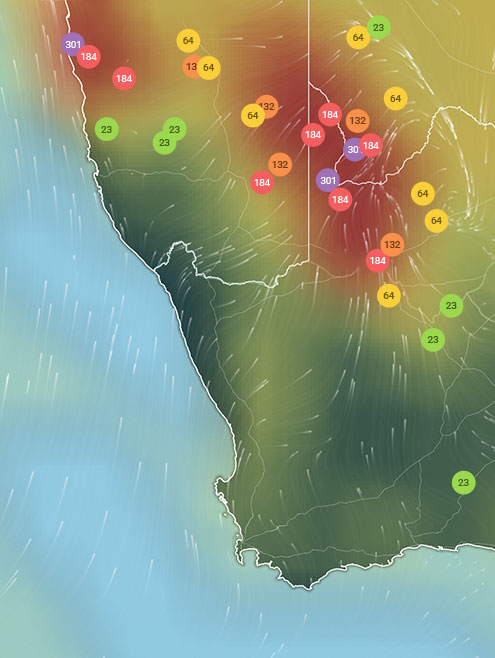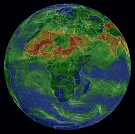Get a monitor and contributor to air quality data in your city.
84.7K people follow this city






AIR QUALITY DATA CONTRIBUTORS
Find out more about contributors and data sources| Weather | Clear sky |
| Temperature | 98.6°F |
| Humidity | 23% |
| Wind | 2.6 mp/h |
| Pressure | 29.7 Hg |
| # | city | US AQI |
|---|---|---|
| 1 | San Sai, Chiang Mai | 168 |
| 2 | Chiang Mai, Chiang Mai | 162 |
| 3 | Doi Saket, Chiang Mai | 161 |
| 4 | Mae On, Chiang Mai | 161 |
| 5 | Mae Mo, Lampang | 154 |
| 6 | Uttaradit, Uttaradit | 146 |
| 7 | Sam Phran, Nakhon Pathom | 142 |
| 8 | Chiang Rai, Chiang Rai | 141 |
| 9 | Hua Hin, Prachuap Khiri Khan | 128 |
| 10 | Mae Sot, Tak | 105 |
(local time)
SEE WORLD AQI RANKING
| # | station | US AQI |
|---|---|---|
| 1 | University of Phayao | 186 |
| 2 | Phayao Provincial | 129 |
(local time)
SEE WORLD AQI RANKINGUS AQI
163
live AQI index
Unhealthy
| Air pollution level | Air quality index | Main pollutant |
|---|---|---|
| Unhealthy | 163 US AQI | PM2.5 |
| Pollutants | Concentration | |
|---|---|---|
| PM2.5 | 78.2µg/m³ | |
PM2.5
x15.6
PM2.5 concentration in Phayao is currently 15.6 times the WHO annual air quality guideline value
| Avoid outdoor exercise | |
| Close your windows to avoid dirty outdoor air GET A MONITOR | |
| Wear a mask outdoors GET A MASK | |
| Run an air purifier GET AN AIR PURIFIER |
| Day | Pollution level | Weather | Temperature | Wind |
|---|---|---|---|---|
| Wednesday, Apr 24 | Unhealthy 153 AQI US | 105.8° 80.6° | ||
| Thursday, Apr 25 | Unhealthy 154 AQI US | 107.6° 78.8° | ||
| Friday, Apr 26 | Unhealthy 155 AQI US | 105.8° 77° | ||
| Today | Unhealthy 163 AQI US | 107.6° 77° | ||
| Sunday, Apr 28 | Moderate 73 AQI US | 109.4° 78.8° | ||
| Monday, Apr 29 | Moderate 75 AQI US | 107.6° 80.6° | ||
| Tuesday, Apr 30 | Moderate 77 AQI US | 107.6° 78.8° | ||
| Wednesday, May 1 | Moderate 77 AQI US | 109.4° 77° | ||
| Thursday, May 2 | Moderate 75 AQI US | 107.6° 80.6° | ||
| Friday, May 3 | Moderate 59 AQI US | 104° 78.8° |
Interested in hourly forecast? Get the app
Phayao is a city located in the northern region of Thailand, being the capital of Phayao province, one of 76 different provinces present in the country. As it is part of the northern region, Phayao is subsequently a city that is subject to some of the more severe levels of air pollution, particularly during the first few months of the year when heavily polluting events are taking place. Forest fires and farmland areas are often set ablaze, under a practice known as slash and burn farming, which despite being classed as highly illegal, still continues unabated.
It is due to the difficulty of enforcing such practices that cities such as Phayao are subject to such bad levels of air quality, with the fires often being started in hard to reach areas or under the cover of darkness. As a result, the citizens of Phayao as well as those visiting may find themselves at risk of developing a number of conditions, ranging from common illnesses or irritation all the way over to more serious health conditions, with a number of them being discussed at the end of the article.
In late May of 2021, Phayao presented with a US AQI reading of 78, placing it into the moderate pollution ratings bracket, which requires a US AQI reading of anywhere between 51 to 100 to be classified as such. Whilst this indicates a level of air pollution that may carry with it a number of chemical compounds, smoke, haze and fine clouds of particles, it nevertheless falls into the category rating that is deemed acceptable by the US Environmental Protection Agency, which deems all readings from 0 up to 150 as being acceptable.
For ease of use, these various ratings within this number bracket are color coded and can be seen above on the air quality map and graph. Good air quality (0 to 50) is marked as green, moderate (51 to 100) is yellow, and unhealthy for sensitive groups (101 to 150) is orange. Whilst it still falls under the acceptable air quality rating, as the name implies, it may present a large amount of health risks for vulnerable portions of population, as well as causing aggravation or irritation to the general public or even healthy young adults. As a result, having preventative measures on hand for when the air pollution level spikes up become of great help, with actions such as wearing fine particle filtering masks and avoiding outdoor exercise or activity all being an aid to reducing health risks and pollution exposure.
Those groups who are classified as being more at risk are ones such as young children and newborns, along with pregnant mothers (whose exposure to pollution can affect the developing child, causing a whole host of potential defects that may affect the child's life, or even result in miscarriage). Others are the elderly and infirm, along with those who have pre-existing health conditions or compromised immune systems. Those with a hypersensitivity towards chemical pollutants or fine particles may also benefit greatly from following up to date pollution readings, as available on the IQAir website or the AirVisual app.
Some of the main pollutants that one would find in the air in Phayao would be those that fall into the US AQI aggregate bracket, with these main pollutants being calculated on their volume present in the air to attain the overall US AQI number.
These are ones such as nitrogen dioxide (NO2), sulfur dioxide (SO2) and ozone (O3), along with the two forms of fine particles, PM10 and PM2.5. Of note is that PM2.5 presents far more danger to the health of those who are exposed to it, with its extremely small size of 2.5 microns or less allowing it to penetrate deep into the tissue of the lungs, and from there enter into the bloodstream.
Black carbon, the main component in soot, is one such harmful particle that can fall under the PM2.5 collective. It has both carcinogenic and climate changing properties, and is often caused as a byproduct of the combustion of both fossil fuels, as well as organic material. Naturally, the burning of vast swathes of forested areas or farmland can cause huge amounts to enter into the atmosphere, causing a whole host of both health hazards and environmental issues. Volatile organic compounds (VOCs) are also produced by these processes, with chemicals such as benzene, tetrachloroethylene, styrene and formaldehyde being part of the VOC collective.
As with most if not all cities in northern Thailand, Phayao has its most polluted months during the burning seasons, which typically begins in December and ends in April. Observing the PM2.5 count on record over 2020, it can be seen that January through to April had the most severe readings of pollution present, coming in with readings of 58.9, 77.8 μg/m³, 113.2 μg/m³ and 71.8 μg/m³.
This made March the most polluted month of the year by a significant amount, with its reading of 113.2 μg/m³ being over ten times what the world health organization (WHO) considers as being ‘good’ air quality. March has shown itself to be the most polluted month every year from 2017 through to 2021, indicating a month in which the pollution caused by the fires is at its most intense, permeating the air with thick amounts of smoke, haze and highly damaging particles.
The months of June through to October as shown in 2020 all presented with very good readings of air quality, once again a common sight in many cities in the northern region of Thailand. June through to September all achieved the WHO's target goal of 10 μg/m³ or less for the best quality of air, coming in at 6.7 μg/m³, 7.5 μg/m³, 7.3 μg/m³ and 9.8 μg/m³ respectively, whilst September also had an equally good reading of 10.5 μg/m³. This is the time period in which the air would be at its best and cleanest in Phayao.
Whilst the above mentioned clean months would carry little to no risks to one’s health, the more polluted months at the beginning of the year would have a whole host of health issues that exposure to them would bring.
They would include chronic obstructive pulmonary disease (COPD), with conditions such as pneumonia, bronchitis, emphysema and asthma all falling under this COPD term. Others would be instances of dry coughs and chest pain, along with increased risk of lung cancer, heart disease or failure, as well as elevated death rates heavily correlated with pollution levels.
2Contributors
Government Contributor
1 station
Educational Contributor

1 station
2 Data sources